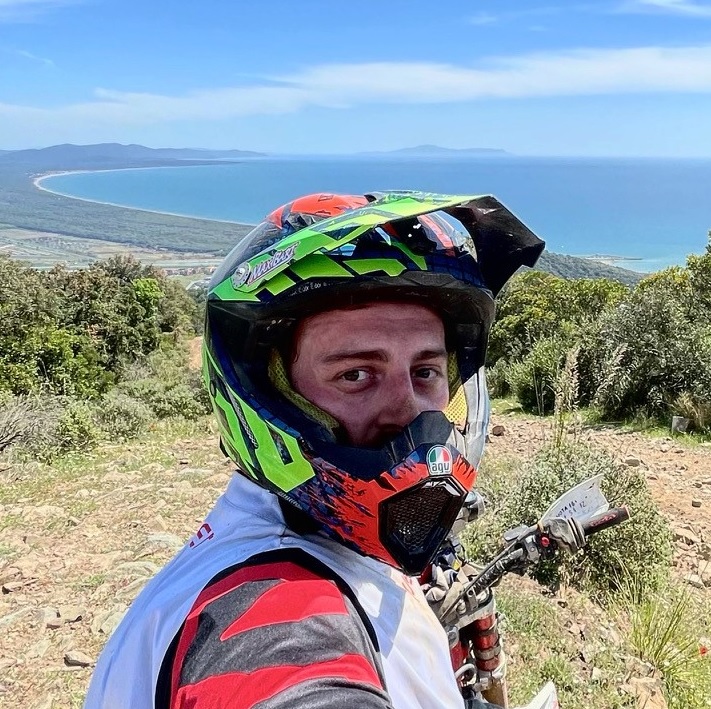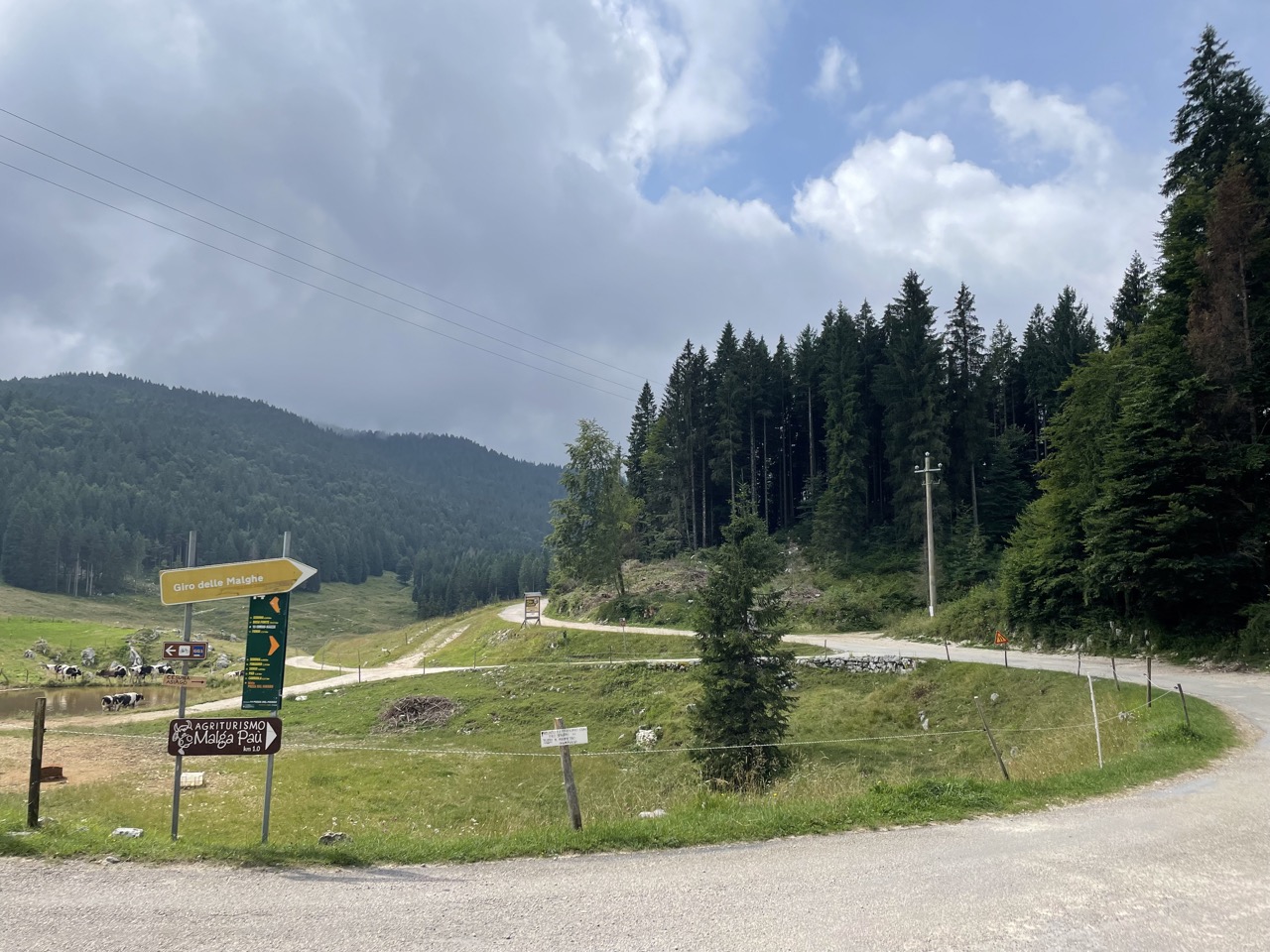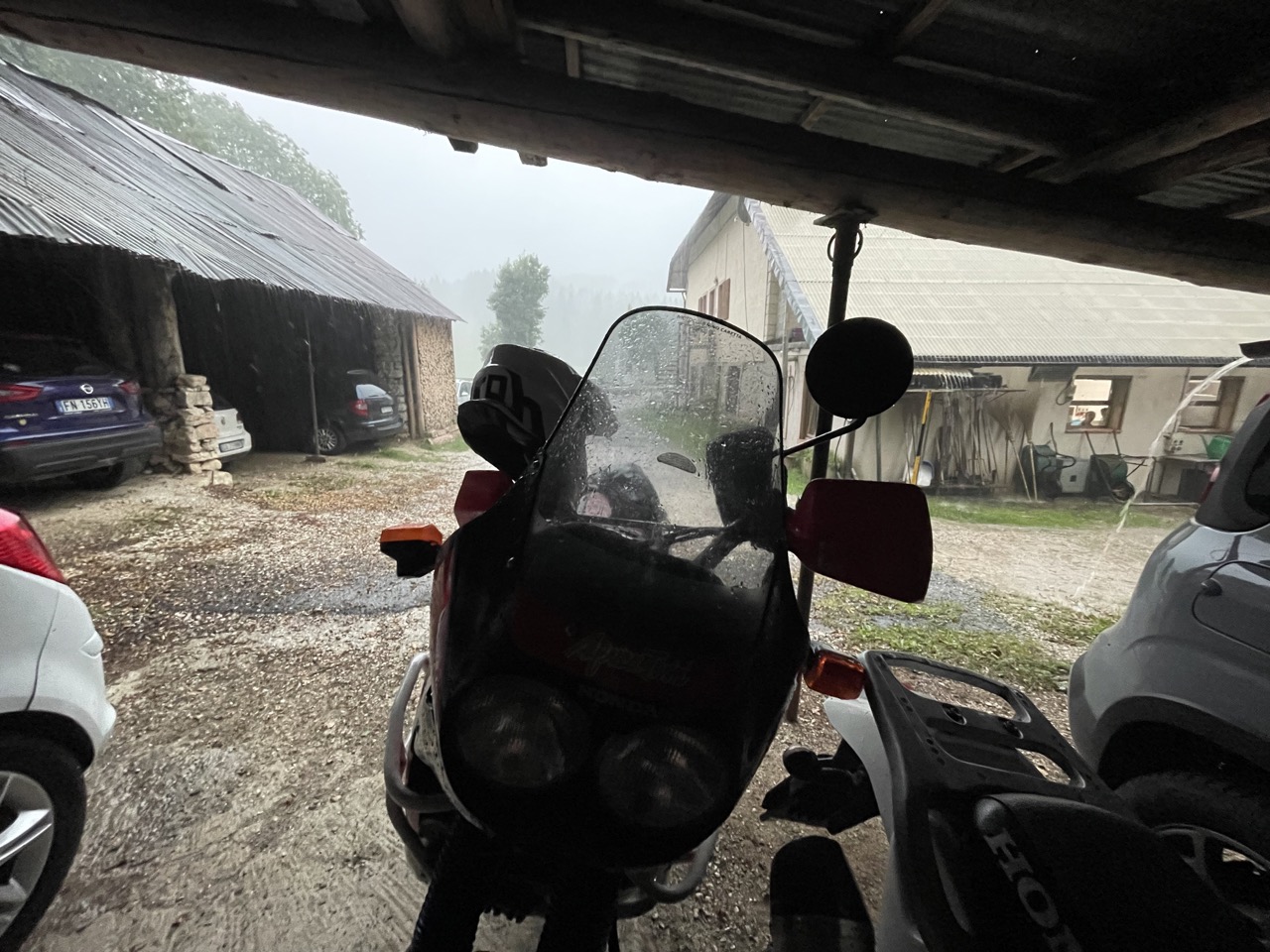
Carlo Pettinato, 30, I've been working at Dainese as part of the marketing since 2017. I live for sports on wheels, with or without an engine, but preferably with knobby tires. I’ve been passionate about enduro, mountain biking and rallying for as long as I can remember. After years on the track, I got an old Honda Africa Twin to keep my off-roader company. A new, vaster and more colorful world, of exploration, opened before me. Having set off from Sardinia, a wild land close to home, I dream of the desert dunes.
“Carlo, I took the Africa home!”
This is my friend Mirko, my car, motorcycle and mountain bike companion, who after years of lusting after my 1993 Africa Twin 750 has finally decided to get his own – an RD04 from 1991, the model predating mine, but there’s little difference between the two. Now, the point is that we need to christen it in style.
“I have a long weekend in Sardinia on 2 June, let’s go see the Rally Championship and have a nice off-road tour in the north-east of the island, can you make it?”
Damn it – he can’t. We’ll have to think something else up. But no worries, as there are plenty of possibilities just an hour from home. One of our great classic outings is a motorcycle tour on the Asiago plateau. Close by, it’s a splendid setting brimming with historically significant sites and featuring lots of public off-road trails that can be ridden in any condition, even in the rain. The great thing about this area is that there are plenty of unpaved lanes accessible to any vehicle, even cars, and in fact locals use them every day. You don’t even need particularly knobby tires; here, at a leisurely pace, you can go pretty much anywhere, even with a motorcycle more suited to road riding. It’s excellent for those who want to try some off-road riding but don’t have much experience. Of course, if you have a suitable motorcycle and tires you can do it all in safety and will enjoy it much more.
So, there we are, headed northbound on the A31 for a day of enduro touring on our vintage twin-cylinder motorcycles.

Due to various postponements, it’s now the middle of July and it’s hot on the plain, but obviously the mountain climate is cooler and can turn quickly. Today, I chose to wear a ventilated summer touring jacket, the excellent Dainese Desert, and I brought along its windproof lining, as well as a waterproof jacket. The weather at home is nice, but you never know. Together with the jacket, I’m wearing off-road pants and adventure boots with Gore-Tex® membrane – the Dainese Seeker boots – featuring soles with excellent grip, the ideal balance of protection and comfort. I also have the AGV AX9 Carbon adventure helmet with the all-important sunglasses under the visor, at least while this lovely sunny weather lasts. My companion opted for a four-season suit, the old but still effective Dainese D-Explorer, perfect for all conditions, with all the air vents open, at least for the moment.
The motorcycles don’t need much doing to them for a one-day outing like this: A cell phone holder to reach the start of the itinerary is enough. To have as much fun as possible, however, we both equipped our Africa Twins with a nice pair of mean-looking knobby tires, not the best in terms of durability – and not even strictly necessary – but nonetheless the best when riding off-road.

At a speed of 110 km per hour – we don’t trust our old steeds enough to push them too much – in less than an hour we’re at the foot of the Costo, in the Caltrano municipality. But we’re not here for bends and suchlike, so we choose an alternative route to attack the plateau. We head toward Calvene and then go up to the hamlet of Mortisa for the legendary “PS Cavalletto”, a road beloved by car rally enthusiasts, an absolute classic in the Città di Bassano race. A strip of asphalt with not much traffic, moderately narrow, winding and not even in great condition, but potholes and dirt are not an issue with these motorcycles. The surrounding scenery, however, is beautiful, especially when approaching the top of the eponymous Mount Cavalletto. We speed through woods and pastures and it’s nice to see how the vegetation changes as you climb – going from hilly to mountainous, with pines and other conifers.
At the famous “Salto dei Granatieri” we take a turn to the left toward the “Giro delle Malghe” (“Tour of the Alpine huts”), a lovely mixed tarmac and gravel road that leaves the woods and almost overhangs the plain, with spectacular views. Here, the weather is not as clear as it was at home, there are some low clouds and the fog is rising along the mountain side. The conditions make it all the more adventurous, even though we’re not even 100 km from home. We go past the Serona, Foraoro, Sunio, Pau and Carriola Alpine huts. These are areas that I know well enough but not perfectly – I’ve been through here several times yet I’m still not fully familiar with the trails. At a crossroad, there is asphalt on the right and dirt on the left: No need to guess which turn we take. After some deliberation, we figure we’ll emerge in Cesuna, around the Kubelek shelter. After a few miles of smooth gravel road, immersed in what look like Scandinavian woods – indeed, this part of the Asiago plateau is more or less flat – we end up just where I thought we would.
We cross the center of Cesuna and follow the main road to the picnic area. Here, we head back into the woods and pass under the former railway tunnel, where the train used to come up from Piovene Rocchette to Asiago. The story of the “Vaca mora”(“Black cow”) line, built at the beginning of the 20th century and decommissioned in the 1950s, is an interesting one. Originally created to facilitate transport for local industry, during the Great War it was widely used to resupply the plateau region, and was subsequently employed to transport people. Those who love these kind of “archeological features” might find it interesting to look further into its history.
But let’s go back to our Africas and riding the dirt roads on the Asiago plateau. We get lost and end up in a maze of roads and narrow lanes – the next landmark is the Boscon British Cemetery, another fascinating and perfectly maintained place. Further on, at the “Bar Alpino” – just a hut in the middle of the woods – we follow the directions for Mount Corno. In the meantime, the weather gets worse – the temperature is perfect, at around 20 °C, but the sky is overcast and doesn’t look very promising.
For the moment, however, we’re dry and having a lot of fun. These wide and easy white stone dirt roads are spectacular in every way, whether you’re riding at a lively speed, “motorally style”, or at a leisurely pace to take in the wood’s atmosphere and scents. We do a little of both, allowing ourselves some fun but also managing to enjoy the moment.

A short asphalt stretch between the Granezza shelter and Mount Corno’s war memorial, and then we’re back off-road, heading toward Turcio. The weather keeps on getting worse, and we’re now immersed in the clouds and hear some thunder not too far away. We have our raincoats handy, but decide to wait until it really starts to rain.
It doesn’t take long – within five minutes, a few sparse drops turn into a serious downpour. We stop, quickly get into our gear and in just a moment we’re ready to go on. But now it also starts to hail! We exchange a knowing glance and as soon as we’re out of the woods we take shelter in the first restaurant we find. All in all, we were really lucky – not even ten minutes in the rain and just a couple of minutes in the hailstorm. The motorcycles are under a shed and we’re sitting comfortably at a table. After all, it’s 12.40 p.m. and I can’t deny we’re feeling a bit hungry.
The lunch break is longer than expected due to the rain that won’t let up, but the atmosphere is nice and chatting away also helps us decide how to continue our tour. We just need to be patient and when the clouds blow away, the sun comes out again and we can leave. We head toward Gallio and then further up, toward the Campomulo shelter. After Campomulo we go back onto a dirt road, once more immersed in a lush pine forest. Despite the heavy rain, the terrain is excellent. The rocky ground drains the soil to perfection, there’s no trace of mud and, actually, the water has completely got rid of any potential dust. There are just a few puddles, perfect for playing around in like kids.
From Mount Fior, the view is spectacular. The rain has swept away the mist and now that the sky is clear we’re enjoying amazing scenery. Far away, we glimpse our Euganean Hills, while looking east we can clearly see the Venetian Lagoon and the Adriatic Sea; below us are the Valsugana valley and the massif of Monte Grappa – it feels as if we could plunge down into them. We ride at a leisurely pace, amid incredibly green pastures, totally alone. The only person we meet is a shepherd, who greets us with a nod of the head and half a smile.
At the end of the dirt road, we find ourselves in the vicinity of the Plain of Marcesina, a large clearing straddling the Veneto and Trentino regions, mostly part of the Enego area. This place is another small piece of paradise – and even more so before storm Vaia hit in 2018. Due to our extended lunch break, we completely ignore the turn that would have taken us back toward Campomulo and then to the Mandrielle hut. Instead, we take the asphalt road leading toward and beyond the Enego 2000 ski resort, to the beginning of the ascent to Fort Lisser. We take another gravel road that at first runs through a beech forest, in which the sun’s rays struggle to penetrate, regaling us with some uniquely beautiful light effects, then we’re out, surrounded by meadows. The terrain is perfectly maintained, so much so that we feel guilty for the quick bursts of speed we need to diagonally negotiate the bends with our Africas. We apply some self-control...

Needless to say, at the top of Mount Lisser the 360-degree view is breathtaking. Moreover, as compared with the previous scenery, now we can admire the Dolomites. Towering up just in front of us is the Pale di San Martino range, flanked by the dark Lagorai range – it feels as you could just reach out and touch them. We circle around the fort on our motorcycles, then stop and turn them off, to enjoy a silence broken only by the howling wind, and take in the monument’s historical significance. Fort Lisser is a fortress built between 1911 and 1914 to defend the border between Italy and Austria-Hungary; since the 1990s it has belonged to the Enego municipality, which oversaw its renovation. Today it’s in good condition and open to visitors.
We take a photo of the view, and then the climax to the day.
“Carlo, what’s the pressure on your rear tire?” “I didn’t check, probably around two BAR!” “It looks a bit deflated...”
It’s not just “a bit deflated” – it’s totally flat. A long stream of expletives follows, but I immediately start thinking about what can be done to resolve the situation (and I forget to take even one photo of the fort, a shame...). In the meantime, I notice and remove a nice rusty nail that I hope will at least turn out to be an old relic from the war.
So, how do we repair a flat tire? It’s Friday, as luck would have it, so tire dealers are open. We descend the way we came slowly, and in the meantime I think about the situation. Bassano is not too far, there must be a tire dealer there; however, I decide to see if I can find one on the plateau, even if it’s past 4 p.m. and we’re at the end of our tour anyway, so we head toward Asiago.
I spend most of the way – 23 km on asphalt – mentally thanking Mr. Mitas for manufacturing such good tires. This E09 is basically a runflat tire, on a straight stretch I can easily do 80 km per hour and perhaps even more, it’s only on the bends that I need to be careful, as leaning is not that good. I vaguely consider going back home like this, but after 100 km the tire would be totally worn out and I’d have to throw it away. In Asiago, we find an open tire dealer, I deal with the wheel myself to save time, replace the inner tube, and we’re ready to come back home.
But not before snapping the clutch cable soon after departing. I decide to see the funny side, and I have the whole descent from the Costo to ponder how to speed up again after the toll booth...